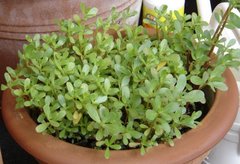| Purslane | ||||||||||||||
|---|---|---|---|---|---|---|---|---|---|---|---|---|---|---|
| Scientific classification | ||||||||||||||
| ||||||||||||||
| Binomial name | ||||||||||||||
| Portulaca oleracea L. |
Purslane, also known as Little Hogweed or Pusley, is an annual succulent in the Portulacaceae family. It is a native of India and the Middle East, which can reach 40 cm in height. It has smooth, reddish, mostly prostrate stems and alternate leaves clustered at stem joints and ends. The yellow flowers have five regular parts and are up to 0.6 cm wide. Blooms first appear in late spring and continue into mid fall. The flowers open singly at the center of the leaf cluster for only a few hours on sunny mornings. Seeds are formed in a tiny pod, which opens when the seeds are ready. Purslane has a taproot with fibrous secondary roots and is able to tolerate poor, compacted soils and drought.
Although purslane is considered a weed in the United States, it can be eaten as a leaf vegetable. It has a slightly sour and salty taste and is eaten throughout much of Europe and Asia. It can be used fresh as a salad, or cooked like spinach, and due to its mucilaginous quality it is also suitable for soups and stews.
Purslane contains more Omega-3 fatty acids than any other leafy vegetable plant. It also contains vitamins (mainly vitamin C, and some vitamin B and vitamin A), as well as dietary minerals, such as magnesium, calcium, potassium und iron.

